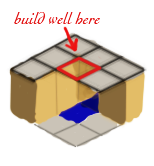- v50 information can now be added to pages in the main namespace. v0.47 information can still be found in the DF2014 namespace. See here for more details on the new versioning policy.
- Use this page to report any issues related to the migration.
40d:Well
|
b-l | |||||
| |||||
| Construction | |||||
|---|---|---|---|---|---|
| Materials | Jobs | ||||
|
1 of | |||||
| Purpose | |||||
| |||||
| This article is about an older version of DF. |
Wells are structures that serve as water sources for your dwarves. A well can be an important feature of a fortress - wells are not absolutely necessary, but they provide so much that few forts stay without them if they can help it.
Wells provide an emergency drinking source in case the alcohol runs out (don't let that happen!). A well is a water source that (if constructed correctly) will not freeze in the coldest weather, and should last in hot. Because the water from a well is never seen as stagnant, the dwarves won't wait until they're thirsty and miserable to drink from a well should they need to.
Using a well provides that dwarf with a happy thought, especially if you make the well with high-quality chains and buckets, or the building designer produces a high quality result. The unhappy thought that a dwarf gets from murky or contaminated water will not occur if the dwarf drinks that very same water by way of a well. A well even allows dwarves to drink from salt water (though this may be a bug).
Badly wounded dwarves will drink only water while recuperating, never booze, so you better have a well or water zone ready for when anyone gets injured, and certainly before the first goblins show up.
Using the well (10 times) will take a small amount of water from the water tile below (1/7 from that one tile), so it will eventually dry up if not replenished.
Also, dwarves can (and will) fish from a well if that labor is designated. This does not harm the well.
A well can be defined as a meeting area with the q key. Un-defining the meeting area will break up any party that is currently formed around a well, and it can immediately be re-defined if you wish.
Note that wells do not prevent attacks from carp, sturgeon, or other aggressive fish if the well is built on the z-level immediately above the water.
Building a well
When constructing a well, it is important to consider placement, safety, the source of the water, and any water pressure to avoid flooding your fortress by accident. For a wider discussion of adding a well to your fortress, see the (recommended) well guide.
Wells must have a clear vertical pathway straight down to their water source. That source can be an artificial channel, an aquifer, a river, a brook, a lake, or an artificial reservoir, so long as it has water in it that's at least 3/7 deep. The water can be any distance directly below the well. If there is 7/7 deep water somewhere directly below the well, then the depth of the top tile of this water does not matter.
It is less work to create a well that draws water from sources lower than an existing ground level, but above-ground sources can also be used so long as you construct the well (and first any floor needed to support it) on a z-level above the water's level.
To build a well you will need the following components:
- a block
- a bucket
- a chain or rope
- a mechanism
- ...and an area over open space.
To place a well, press the b, l keys. That will take you through the various components, and you can choose specifically from among the parts you have available in each category. A well needs to be placed over an open space with adjacent floor tiles, there does not need to be water underneath a well for it to be built, only for it to be active.
It requires a dwarf with the architecture labor designated to design, and then a mason/carpenter/metalsmith to finish the construction. Because it's designed, high-value materials can be multiplied by a high-quality effort on the part of either or both the steps involved, and can result in an extremely valuable piece of architecture for your fortress.
If a well is working properly, meaning it has direct access to water, it will display "active" when examined with q. If there is something obstructing the well, or there is not enough water, it will display "dry".
It is possible to build wells directly above one another, and they will still function if there is water below - they will not obstruct one another, as they are not impassible structures. Hatches, floor bars and floor grates will block well functionality, if they are between it and the water, but grates and bars will not stop water from flooding out. Grates, bars and hatches will allow functionality again if opened with a lever. It is perfectly reasonable to have multiple well openings drawing from a single water source, as a well only cares about the tile in a straight line below it. Wells cannot function through a stairwell or a ramp. It is possible to have obstacles beneath a well, with the well continuing to function, if the surface of the water is above the obstacles.
See also:
